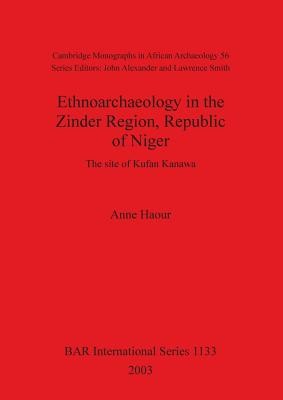
- We will send in 10–14 business days.
- Author: Anne Haour
- Publisher: British Archaeological Reports Oxford Ltd
- ISBN-10: 1841715069
- ISBN-13: 9781841715063
- Format: 21 x 29.7 x 1.1 cm, minkšti viršeliai
- Language: English
- SAVE -10% with code: EXTRA
Ethnoarchaeology in the Zinder Region, Republic of Niger (e-book) (used book) | bookbook.eu
Reviews
Description
Cambridge Monographs in African Archaeology 56
The need for archaeological research in the Hausa area is very real. What work has been done is often casual and cursory. Considering that the modern Hausa heartland includes up to twenty-five million people and is as large as Britain, this neglect cannot be explained in terms of demographics or of scale. Nor can it be excused on the grounds that there is nothing of interest in the soil of the kasar hausa. This volume (the latest in the series of Cambridge Monographs in African Archaeology) focuses on the particular site of Kufan Kanawa, in the Republic of Niger, to illustrate how archaeology can contribute to our knowledge of the past. This site stands out among the many archaeological remains of the Hausa area because of its six-kilometre long stone enclosure and its alleged role as the predecessor site to the widely-known Hausa city of Kano. In this volume archaeological excavation, anthropological interviews, and critique of the historiography of the Hausa area are combined in an attempt to explain why, how and when Kufan Kanawa was settled. At the same time, a study of Kufan Kanawa brings to light a number of general points, applicable to any enquiry into the past. African archaeology is coming to the fore as a rich source of data on the different developmental paths taken by human societies, informing our debates on cultural processes such as the rise of social complexity and of urban settlements, or the role of trade and of migrations. It is hoped that the present study of Kufan Kanawa will contribute to this field. Three main topics run through this volume: the nature of urbanism, the role of trade, and the diffusion of political complexity. A single thread in fact unites them all: the idea that major developments in West Africa could be explained as the result of influences from North Africa.
EXTRA 10 % discount with code: EXTRA
The promotion ends in 21d.11:49:18
The discount code is valid when purchasing from 10 €. Discounts do not stack.
- Author: Anne Haour
- Publisher: British Archaeological Reports Oxford Ltd
- ISBN-10: 1841715069
- ISBN-13: 9781841715063
- Format: 21 x 29.7 x 1.1 cm, minkšti viršeliai
- Language: English English
Cambridge Monographs in African Archaeology 56
The need for archaeological research in the Hausa area is very real. What work has been done is often casual and cursory. Considering that the modern Hausa heartland includes up to twenty-five million people and is as large as Britain, this neglect cannot be explained in terms of demographics or of scale. Nor can it be excused on the grounds that there is nothing of interest in the soil of the kasar hausa. This volume (the latest in the series of Cambridge Monographs in African Archaeology) focuses on the particular site of Kufan Kanawa, in the Republic of Niger, to illustrate how archaeology can contribute to our knowledge of the past. This site stands out among the many archaeological remains of the Hausa area because of its six-kilometre long stone enclosure and its alleged role as the predecessor site to the widely-known Hausa city of Kano. In this volume archaeological excavation, anthropological interviews, and critique of the historiography of the Hausa area are combined in an attempt to explain why, how and when Kufan Kanawa was settled. At the same time, a study of Kufan Kanawa brings to light a number of general points, applicable to any enquiry into the past. African archaeology is coming to the fore as a rich source of data on the different developmental paths taken by human societies, informing our debates on cultural processes such as the rise of social complexity and of urban settlements, or the role of trade and of migrations. It is hoped that the present study of Kufan Kanawa will contribute to this field. Three main topics run through this volume: the nature of urbanism, the role of trade, and the diffusion of political complexity. A single thread in fact unites them all: the idea that major developments in West Africa could be explained as the result of influences from North Africa.


Reviews